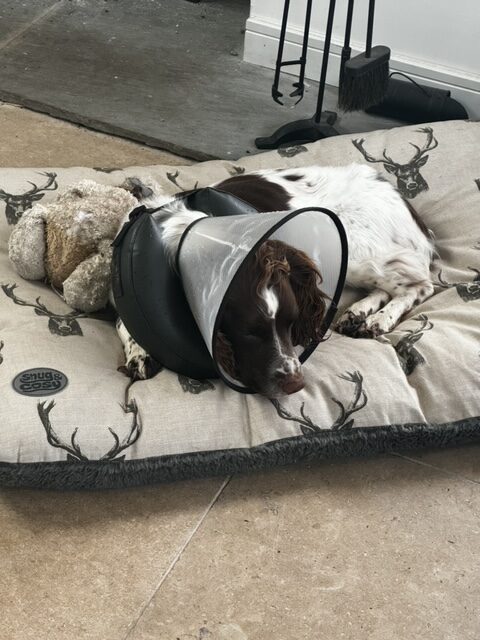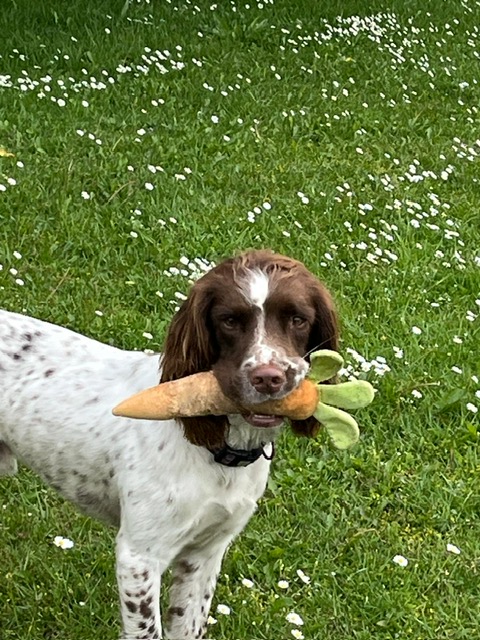Brave Pet of the Month…Wilf!!
Wilf is a lovely two-and- a-half-year-old Springer Spaniel that we first met when he was just 10 weeks old and visiting the practice for his puppy vaccinations.
In January this year, Wilf came to see us as he was unwell; he had started trembling, seemed painful and his owner had noticed he wasn’t using his back legs properly. Upon examination, Wilf’s clinical exam was mostly normal other than some abdominal discomfort and a high temperature of 40.2 degrees.
We decided to start some medications to manage the pain and that would also help lower Wilf’s high temperature. A high temperature can often make our patients feel miserable. Unfortunately, Wilf returned to us the next week; his owners felt he was a bit better whilst on the medications but still not his usual bouncy self! We had a case of a Springer Spaniel who had lost his spring!
On repeat examination, Wilf’s temperature was still high at 40 degrees. At this point, it is important to try and work out what is driving the high temperature. There are many causes including inflammatory, infectious or immune mediated conditions and sometimes identifying the source can be very difficult. In fact, in some patients we may never find a cause and we refer to this as pyrexia of unknown origin (PUO).
Initially, we ran some blood and urinary tests, which suggested an inflammatory process and made autoimmune conditions less likely. It still wasn’t clear where the source of inflammation was but without any further clues on Wilf’s examination or blood work, we decided to start some additional anti-inflammatory medications and continued his pain relief.
However, a few days later, Wilf developed a swelling along his back! This made us suspicious of an abscess which we considered was secondary to a foreign body. This could also explain his prior abdominal pain and PUO. The best way for us to understand what was happening near this swelling and possibly identify any foreign material was to send Wilf for a CT scan of the area.
The CT report showed evidence of a migrating foreign body starting from the lungs, passing along the muscles close to the spine and surfacing and forming an abscess in the abdominal wall near the last rib. It is often hard to believe the course these pieces of foreign material can take but there are many cases and reports we see that are like this!
Actually, wounds caused by foreign bodies are not uncommon in dogs and can be caused by pieces of stick, thorn or grass seeds. They can be noticed quite soon after penetrating the body i.e. in the foot as a local swelling, which will form a small abscess and then rupture, or they can remain dormant and migrate to other parts of the body before they try to make their way out.
Interestingly, in July 2023 Wilf came to see us as he had a swollen toe, and the vet did in fact pull out a grass seed!! We think a grass seed was the likely culprit this time too and we wonder if he had inhaled it at the same time as the original grass seed in his toe!
Wilf had surgery to explore the abscessed area and the draining hole which had developed. The area was explored thoroughly and flushed with water, but no obvious foreign material was found. It can often be the case that the offending piece of foreign material is never seen! To encourage any pieces of material to drain from the wound, his wound was then left open.
Post-operatively, Wilf was given antibiotics, he continued pain medications, and his owners coped wonderfully with his open wound, which can be messy and a little off putting initially! There was an immediate improvement with Wilf after the surgery and as the wound healed, he started to get his spring back! We have seen Wilf very recently and he has fully recovered, and his parents are so happy to have their bouncy boy back!





